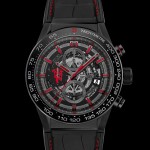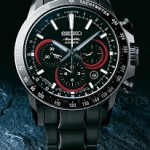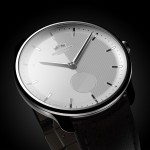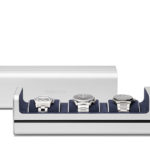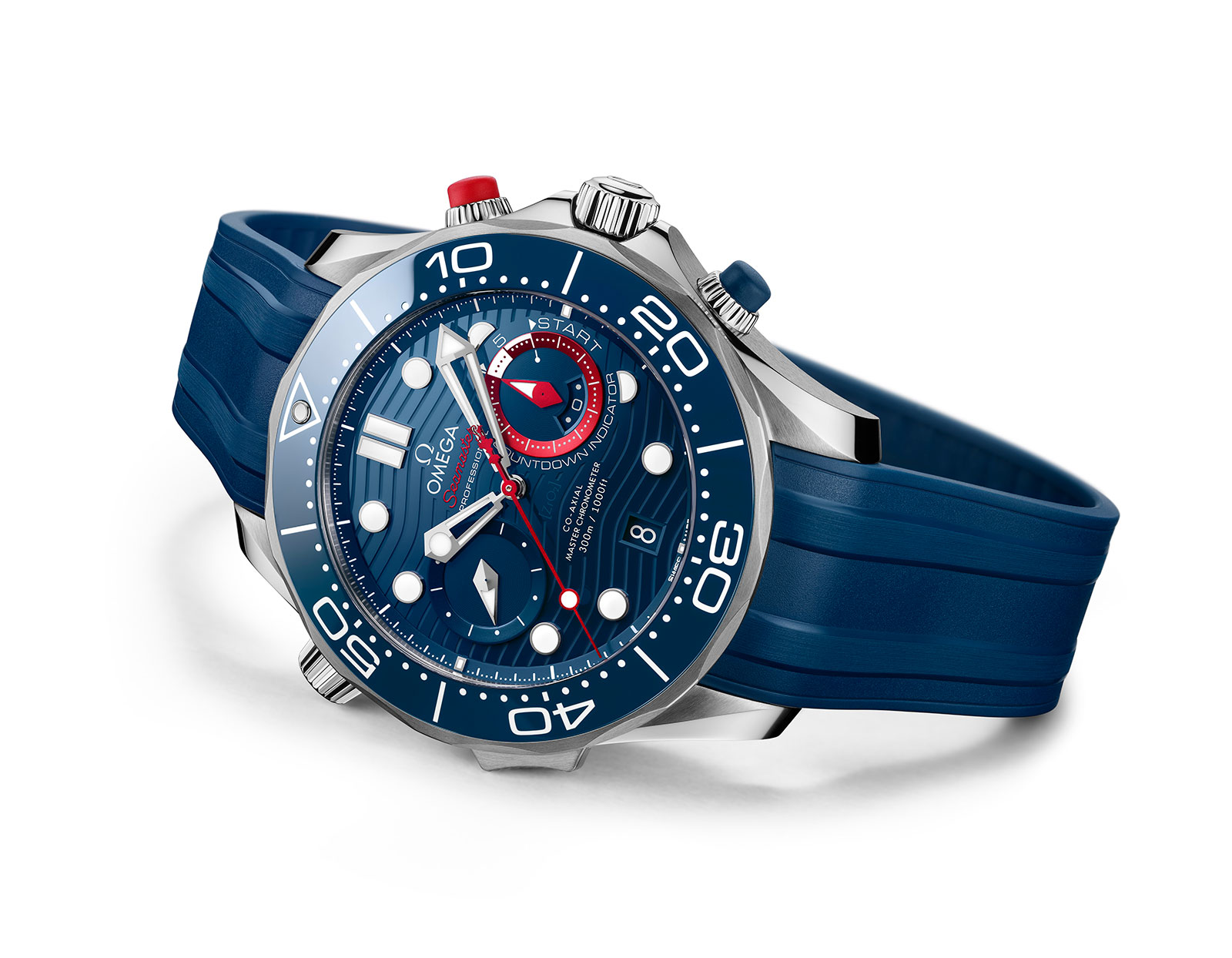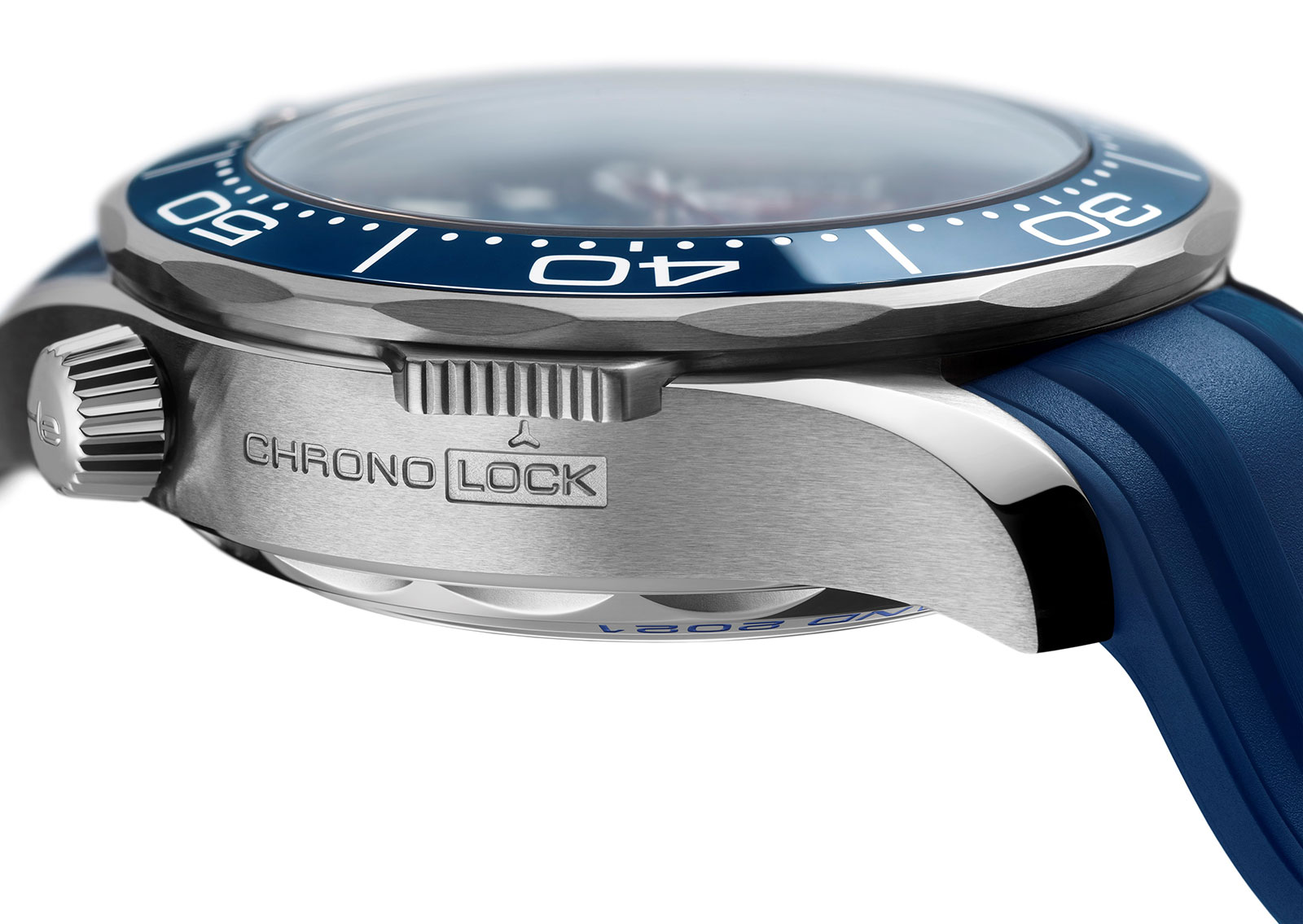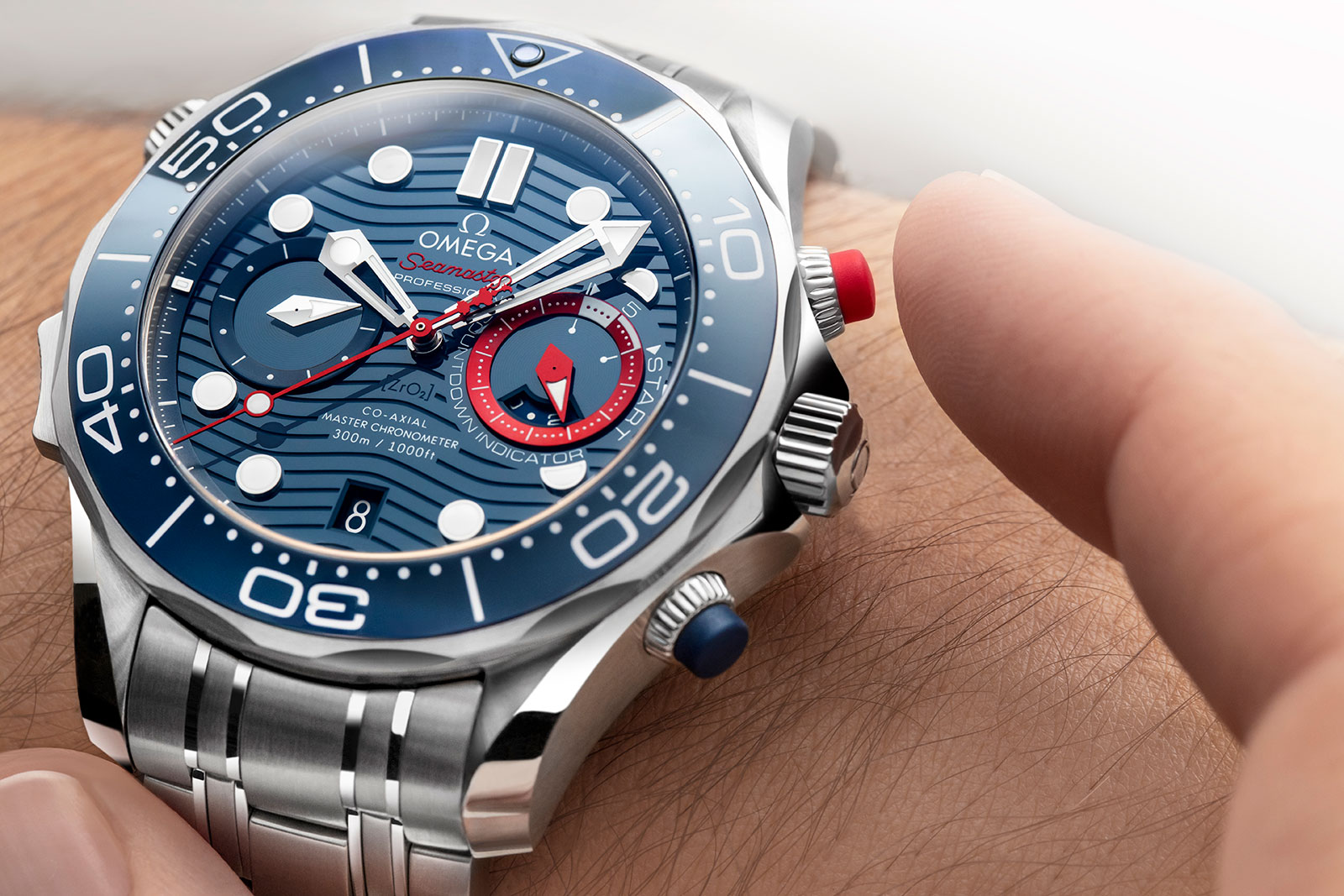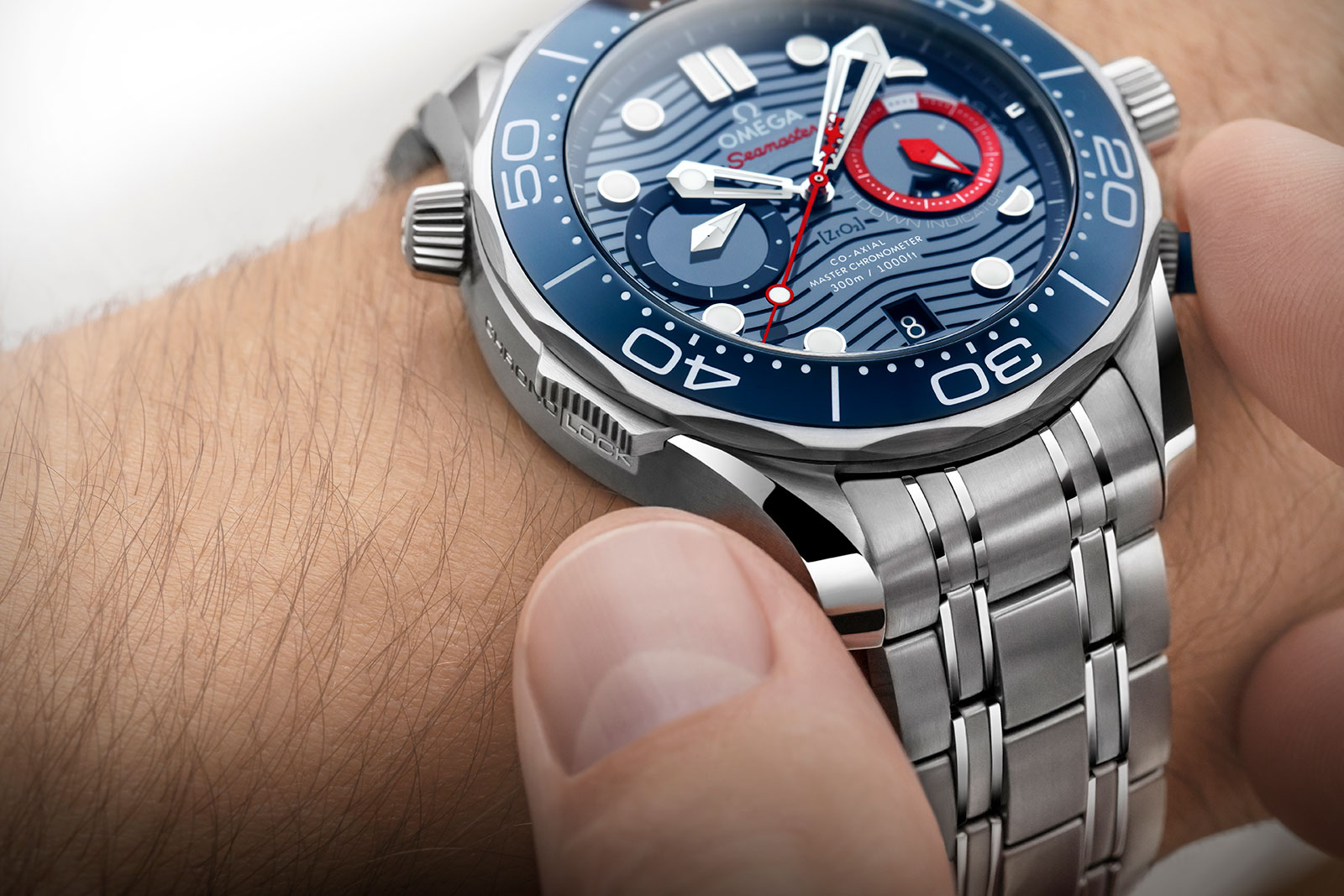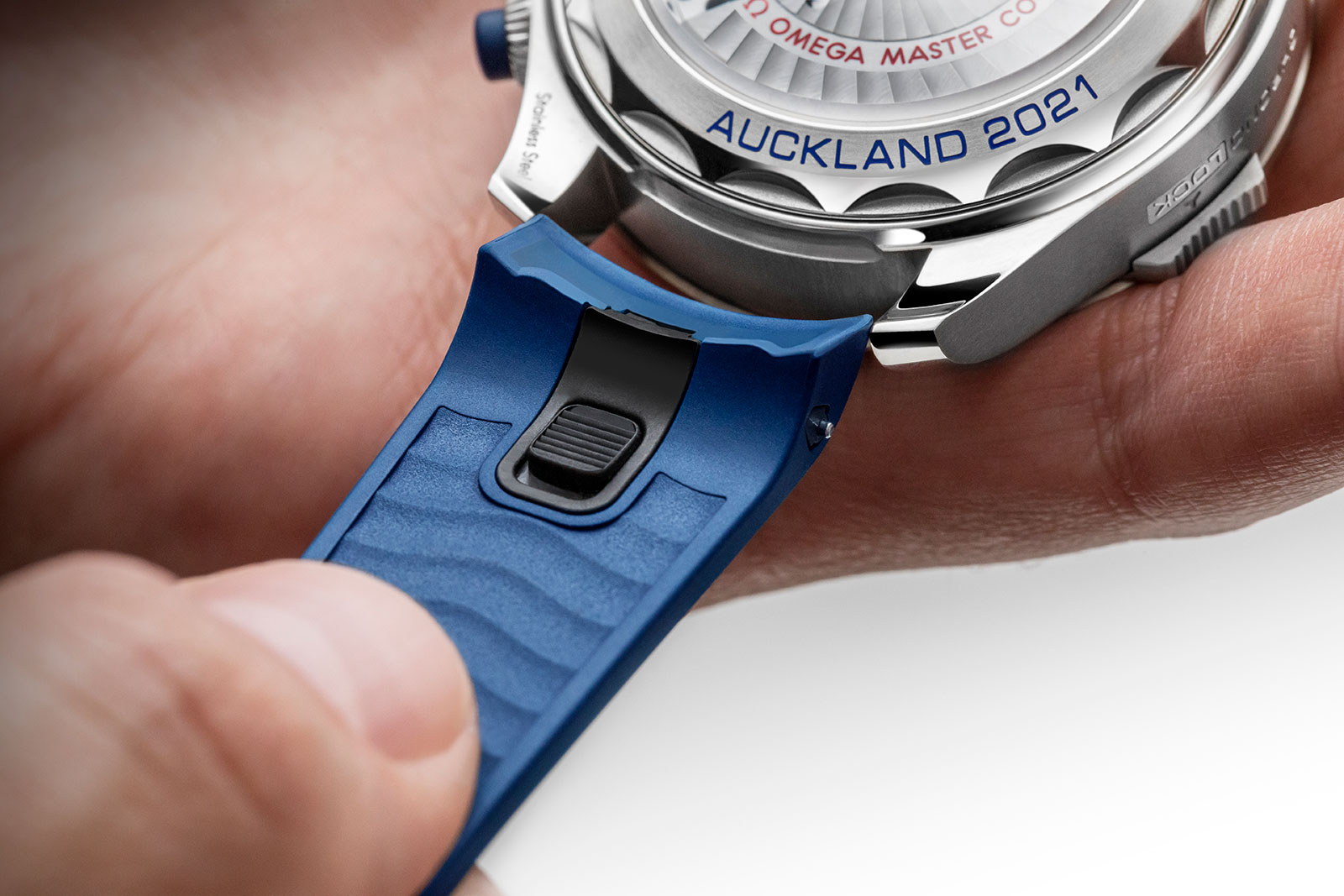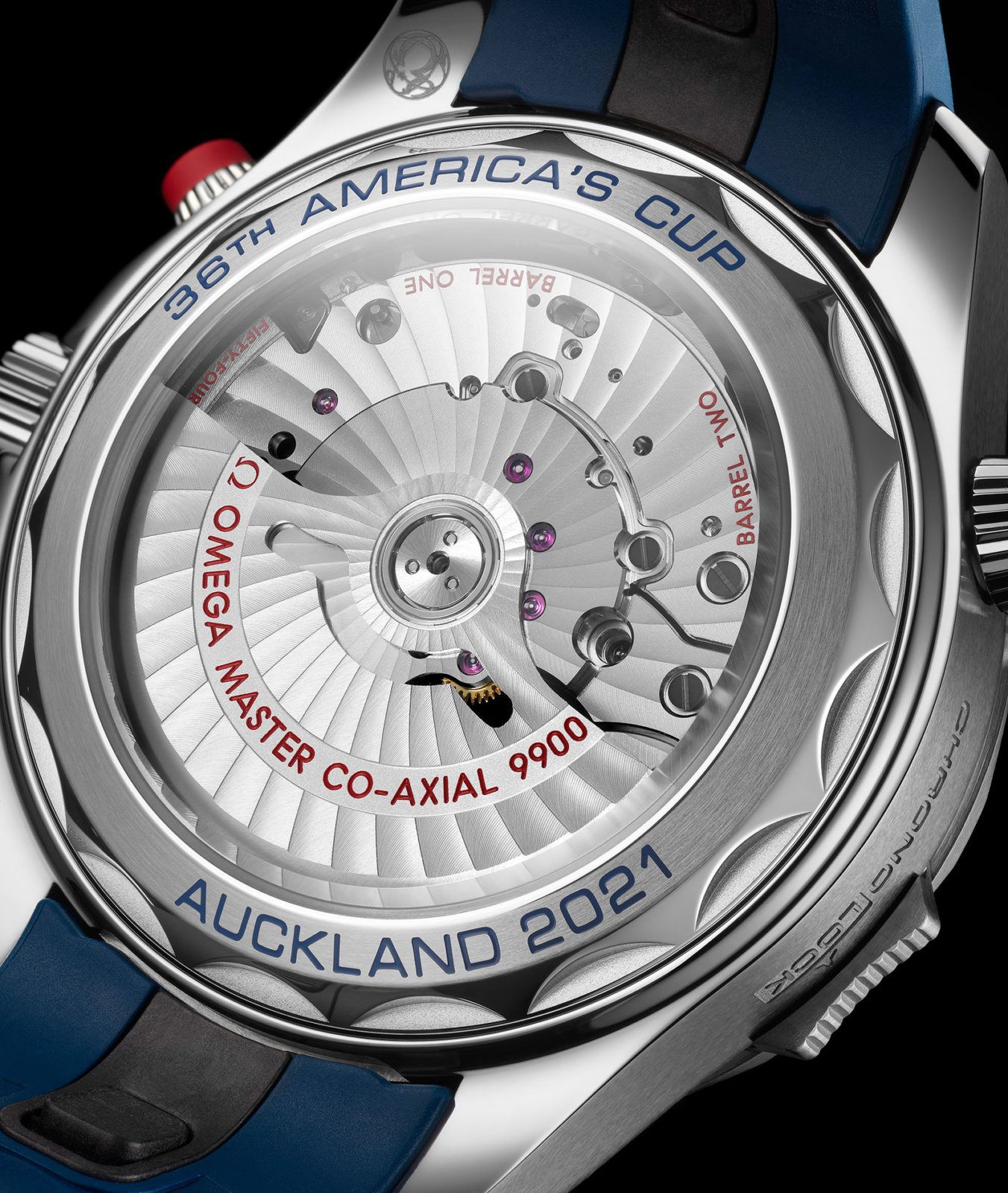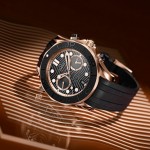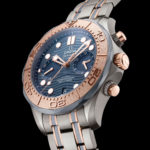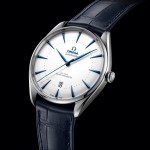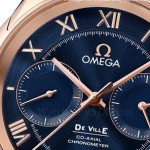In-Depth: Mid-Century Movado Chronographs
Water-resistant Borgel cases, M90, and M95.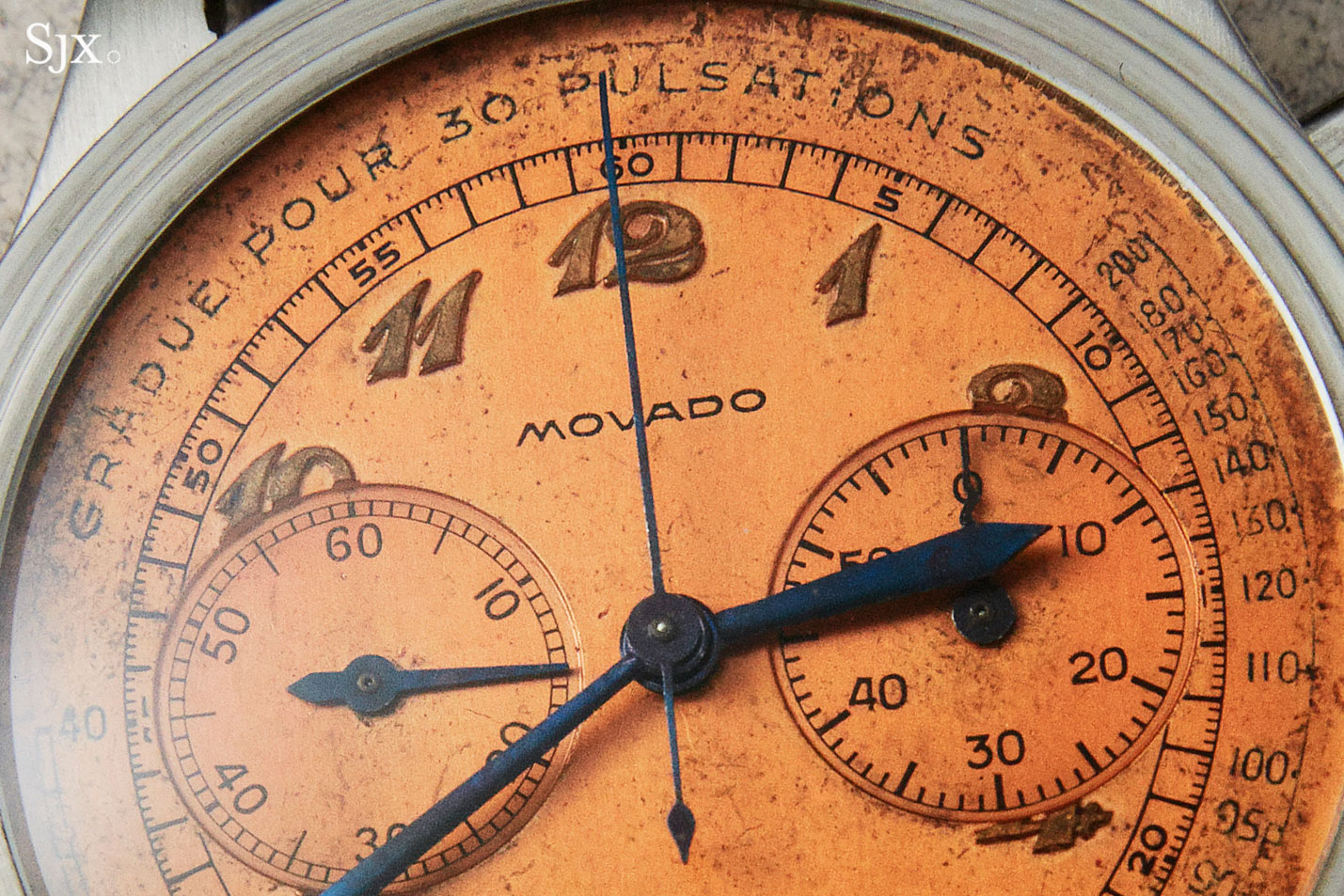
Every time you read a story about the ocean, there’s a good chance you’ll see that it is “95% unexplored”, or “we know more about the surface of the moon than of the seafloor”. As most tropes go, they are as annoying as they are true, and in this case they’re also an apt metaphor for vintage watch knowledge.
While the details of vintage Patek Philippe and Rolex have been mapped down to their going trains, numerous brands remain relatively uncharted – a Marianas Trench’s of knowledge awaiting exploration. Midcentury Movado chronographs lie squarely at those depths; let’s dive in.
As we arrive at the door of our submersible, we must first acknowledge those who have assembled taxonomies of this scantly-explored abyss: the late Fritz van Osterhausen, author of The Movado History, and the excellent M95 chronograph reference the e-newsletter Rescapement published a few years ago. Using their ballast — no, I haven’t run out of nautical metaphors yet — we hope to fathom yet further. Today, we’ll peer into with what many consider the pinnacle of Movado collecting, its exceptionally-cased midcentury chronographs.
History
Until the 21st century, Swiss watch production was predominantly a cottage industry. Specialists manufactured the case, dial, or ebauche (movement blank), and peddled their wares to as many brands as possible. While final products were modified to brand specifications, family traits are easily discernible across marques that shared suppliers.
In the early 1930s, one such case maker, François Borgel (FB), had recently patented the cork stem seal (patent CH 130942 of 1928) and decagonally-shaped, screw-down case back (CH 156807 of 1931). Together, this combination significantly increased water resistance of the case without the need for a screw-down crown.
Early in the decade, FB built prototypes incorporating these patents and presented them to a number of brands, including Movado, Doxa, Mido, and Patek Philippe. At a time when manual-wind watches were the norm, the brands all recognised the case’s commercial potential and placed their orders. By 1935, Movado’s first FB-cased, water-resistant line of watches, the Acvatic, was released. Over the next 30 years, the Acvatic’s chronograph progeny would become a mainstay of the Movado brand and are amongst the most delectable of this sea’s fish.
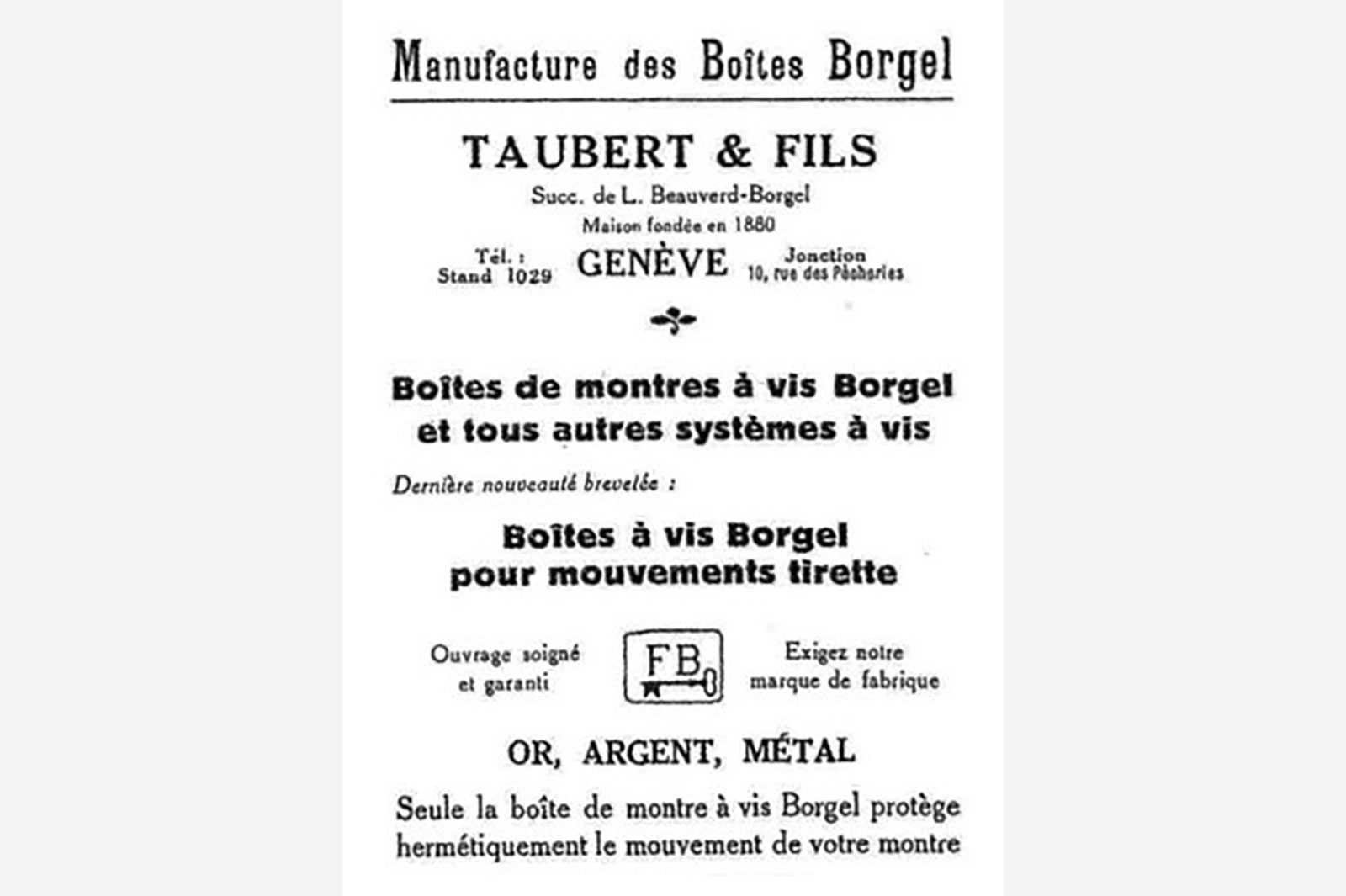
An advertisement for the FB case placed by Taubert & Fils, which acquired FB in 1924, in the April 1925 issue of trade magazine Journal Suisse d’Horlogerie. Image – VintageWatchstraps.com © David Boettcher
Movement manufacture
With a case-maker in the hold, Movado next needed a stalwart movement for its wrist chronograph. Though it usually produced its own calibres, Movado turned to the well-respected firm Frederic Piguet to design an innovative, self-contained chronograph module that could be attached to a base movement.
Piguet succeeded and, in 1938, the first two-register cal. 90M movements were completed, while the three-register cal. 95M followed a year hence. Today, these are colloquially referred to as the M90 and M95. These chronograph movements were modular, derided in our modern era but prized contemporaneously for their form, usefulness, and ease of service — and for incorporating the chronograph without ungainly additions to case thickness. Specifically, the cal. 90M had a chronograph module installed on the back of the movement, while the cal. 95M was essentially a cal. 90M with the addition of a module for the hour register under the dial.
The movements were also characterised by an unusual inversion of the chronograph pushers, with the bottom pusher for start and stop and the top pushers for reset. A testament to their success was their longevity: these 10.5 ligne (26.5 mm) movements were the workhorses for all Movado chronographs until 1969, when the Datron HS 360, an automatic chronograph movement derived from the El Primero, was introduced.
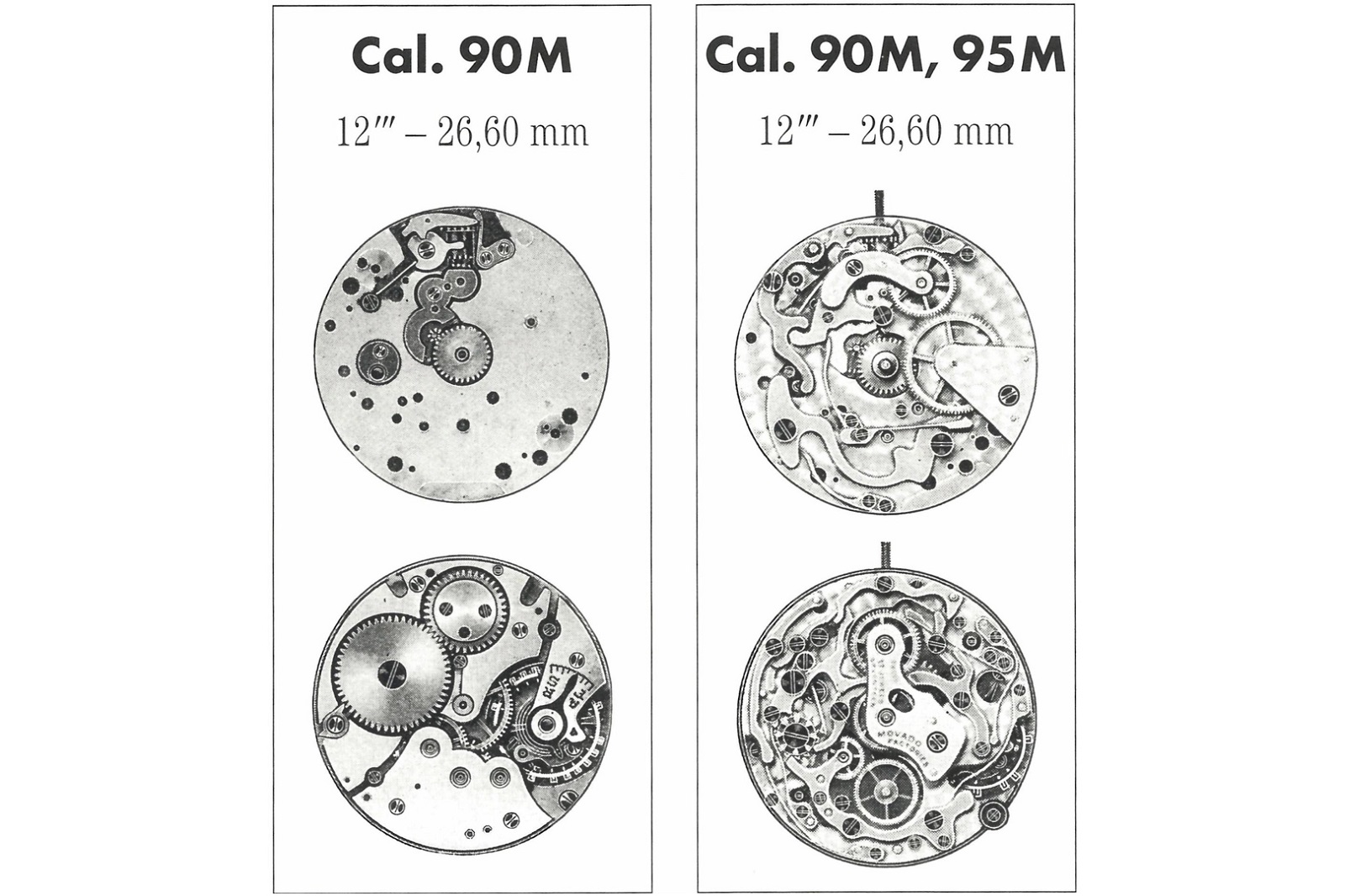
Cal. 90M and 95M illustrations. Image – The Movado History by Fritz van Osterhausen
The “cylinder” cases
So here we are, amidships and yet to present the promised booty of cases. Fear not, Ishmael, for we have arrived. Though case taxonomy isn’t the most exacting of the sciences, there are at least 10 distinct case types for the M90/95 chronographs, and more if your harpoon is sharper. The first style we’ll look at is an FB-produced case popularly referred to as the “cylinder” case, or more technically as case styles denoted by the suffixes “18” for M95 and “28” for M90.
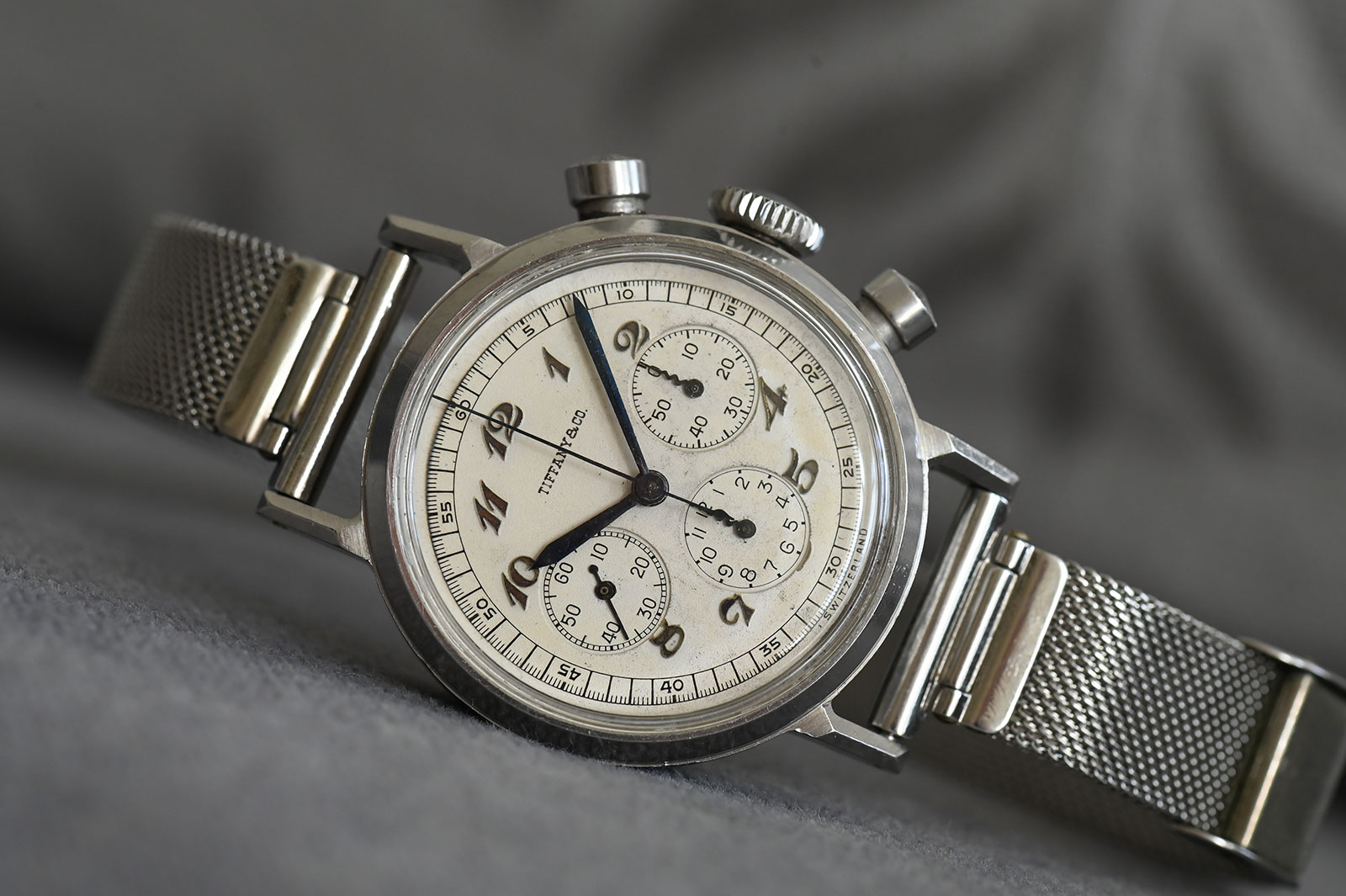
A cylinder-case ref. 19018 with a Tiffany & Co.-signed dial. Image – Kevin O’Dell
An aside: M90/95 case backs have individual serial numbers as well as a case number stamp. Until 1966, case number stamps are written in a format made of [case metal, base calibre, case style]. The metal code is blank for 18k yellow gold, “R” for rose gold, “4” for 14k gold, and “1” for steel. Following the case metal code, the backs of all chronographs from this period are marked “90” for the base calibre, and lastly with the case style.
We will refer to case styles by their two-digit codes throughout the article, such as “18” and “28”. So, the cylinder-case M95 in steel pictured below is marked “1 90 18”. Similarly, a cylinder M95 in 18k yellow gold would be “90 18”, and the same in rose gold, “R 90 18”.
All cases were stamped with an emblem of a hand holding a pocket watch (and steel cases often have “stainless steel” around the hand emblem as well). FB cases were also stamped with the initials “FB” sitting atop a key with “patent” and a cross underneath, which was later replaced by “vacuum”. Additional stamping is sometimes also present, depending on the case metal, and to denote the case was made for a Movado watch, though the specifics of these stamps vary.
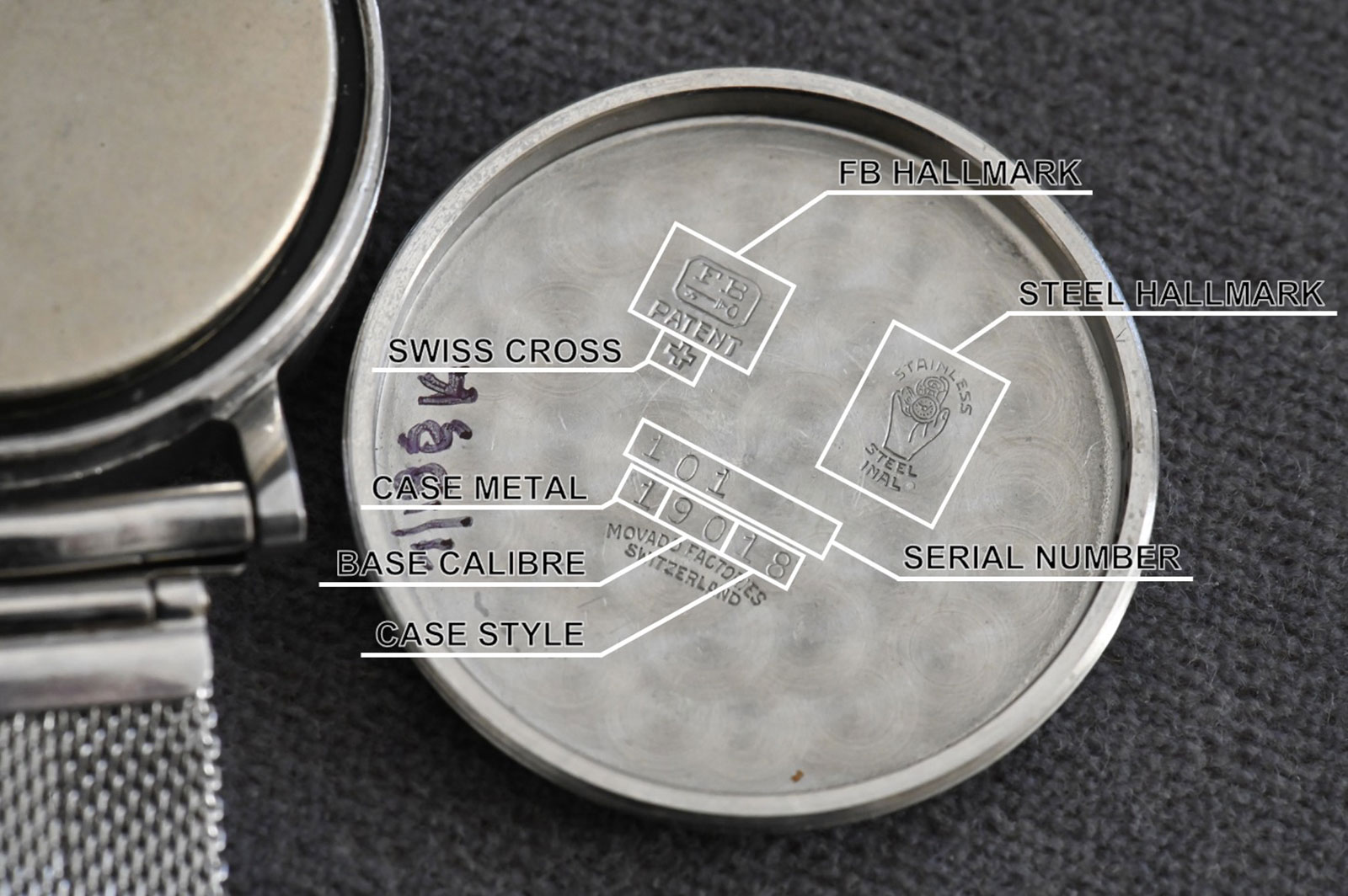
The inside case back of a ref. 19018. Image – Kevin O’Dell
Back to the case at hand. The 18- and 28-style cylinder cases are round with 33 mm diameter and thin, vertically-faceted lugs and pump pushers. A popular feature of this case style is the starburst pattern stamped onto the tops of the pushers, ostensibly added to reduce slippage while using the chronograph. The distinctive pushers and domed crown are the same as those on the Patek Philippe ref. 1463 “Tasti Tondi” and, regardless of their coefficient of friction, they sing to collectors like the sirens of Sirenum Scopuli.
When assessing the condition of a cylinder case, look at the lugs for a small, flat-topped surface extending out from the case, followed by a sharp facet running down the remainder of the top of the lug. The case middle should be vertically brushed, and the case back decagonally-shaped with concentric brushing.
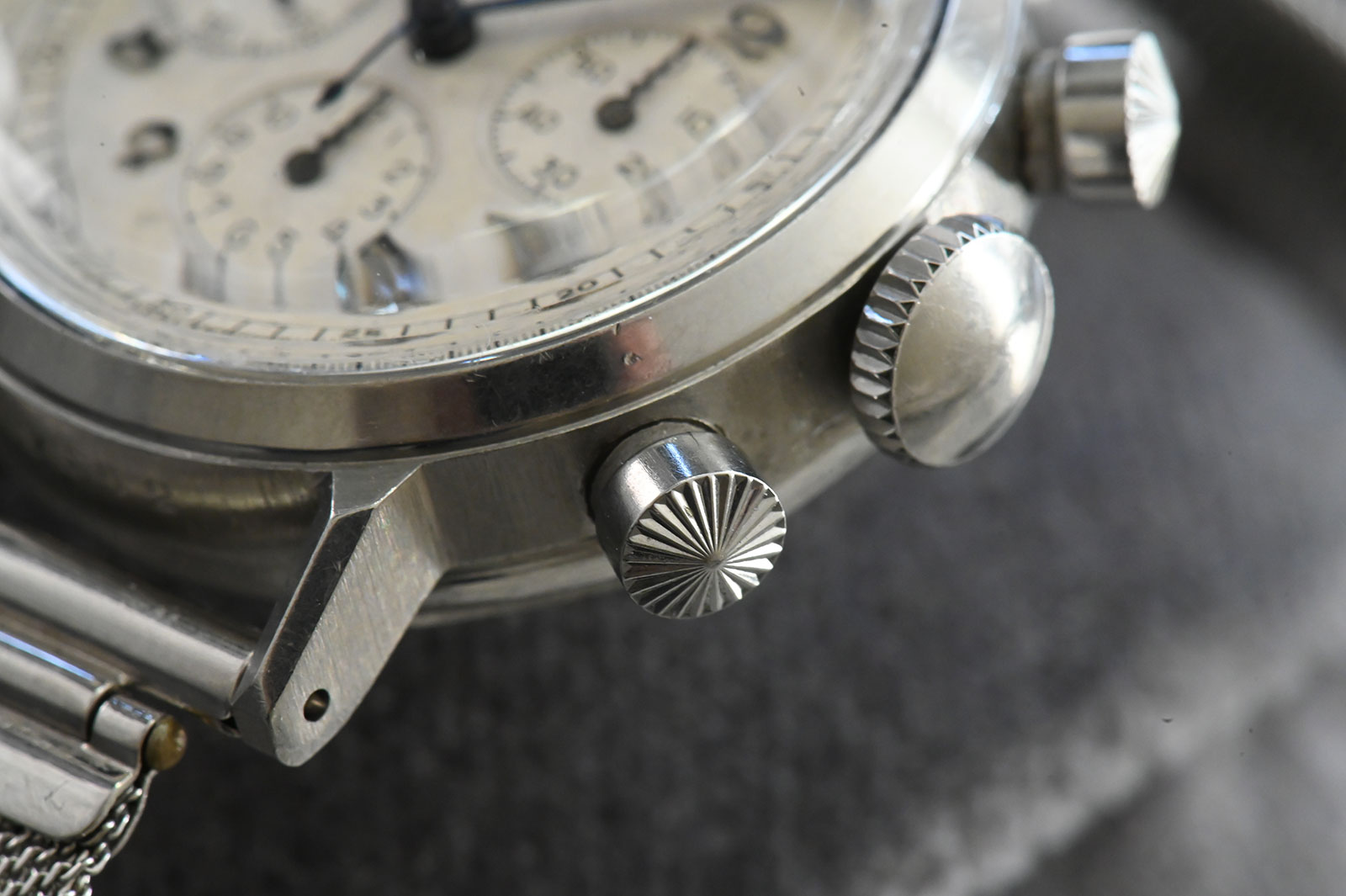
The case details of a ref. 19018. Image – Kevin O’Dell
The faceted cases
Next, we have the first generation faceted case styles, the “38” for M95, and “48” for M90. These were presented in larger, 34.5 mm FB cases that feature the same screw-down back and vertically-brushed case middle as the cylinder style. While they lack the famous starburst-patterned pushers, the graceful domed crown remains.
More prominently, the thin lugs were replaced by a complex, faceted shape that sparkles like the north Atlantic. Now double stepped, the bezel also makes the case appear heftier. Of the FB case styles, this is the most common, though that does not make it less sought after.
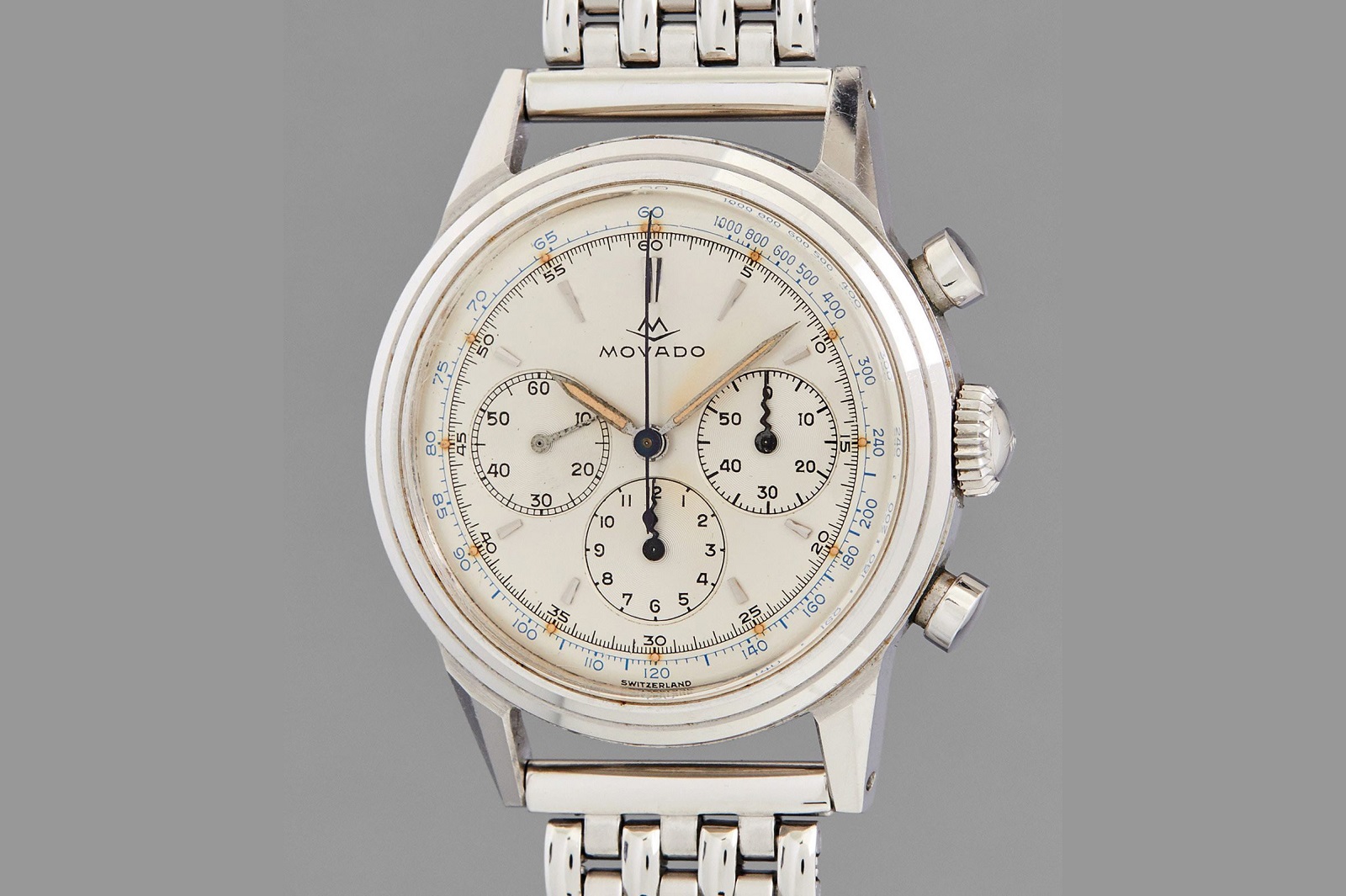
The Type 1 faceted case of a ref. 19038. Image – Phillips
A transitional period for Movado, 1959 to 1966 saw a rapid series of changes to the brand and its watches.
First, in 1959, an “M” logo resembling a hat began to be added to the printed “Movado” branding on the dial, as seen in the watch seen above. The “M” could be printed or applied, and from 1959-1967, dials both with and without this logo are seen. Shortly after the introduction of the “M” logo, production of the “58” M95 began. Initially, the “58” case was visually identical to the “38”, and produced alongside, but it then evolved into a slightly sportier style with facet-less, flat-topped lugs; the Rescapement article noted earlier refers to these faceted case styles as the Types 1 & 2.
Notably, production of the M90 ceased during this period as Movado focused on the three-register chronograph. I have yet to see an M90 in a Type 2 “58” case.
Adding to the confusion, Movado then rejiggered its entire case numbering system in 1966 and gave the Type 2 “58” case a new case number of “68”. And the “68” style is not marked with the previous five-digit code broken down above, but in an eight-digit system of [calibre, metal, case style] where “95” denotes the calibre and then material with “704” for steel, “224” for 18k yellow gold, and “214” for 14k gold.
So, what was once a steel M95 marked “1 90 68” then became “95 704 568”, which we refer to as a “68” for consistency. The “68” retained its Type 2 case until the M95 ceased production in 1969. This later era of M95 was marked by changes to the dials, making them typical of the 1960s, with simpler markers, signed crowns, and “panda” dials. As seen below, however, there were extravagant exceptions to this general trend.
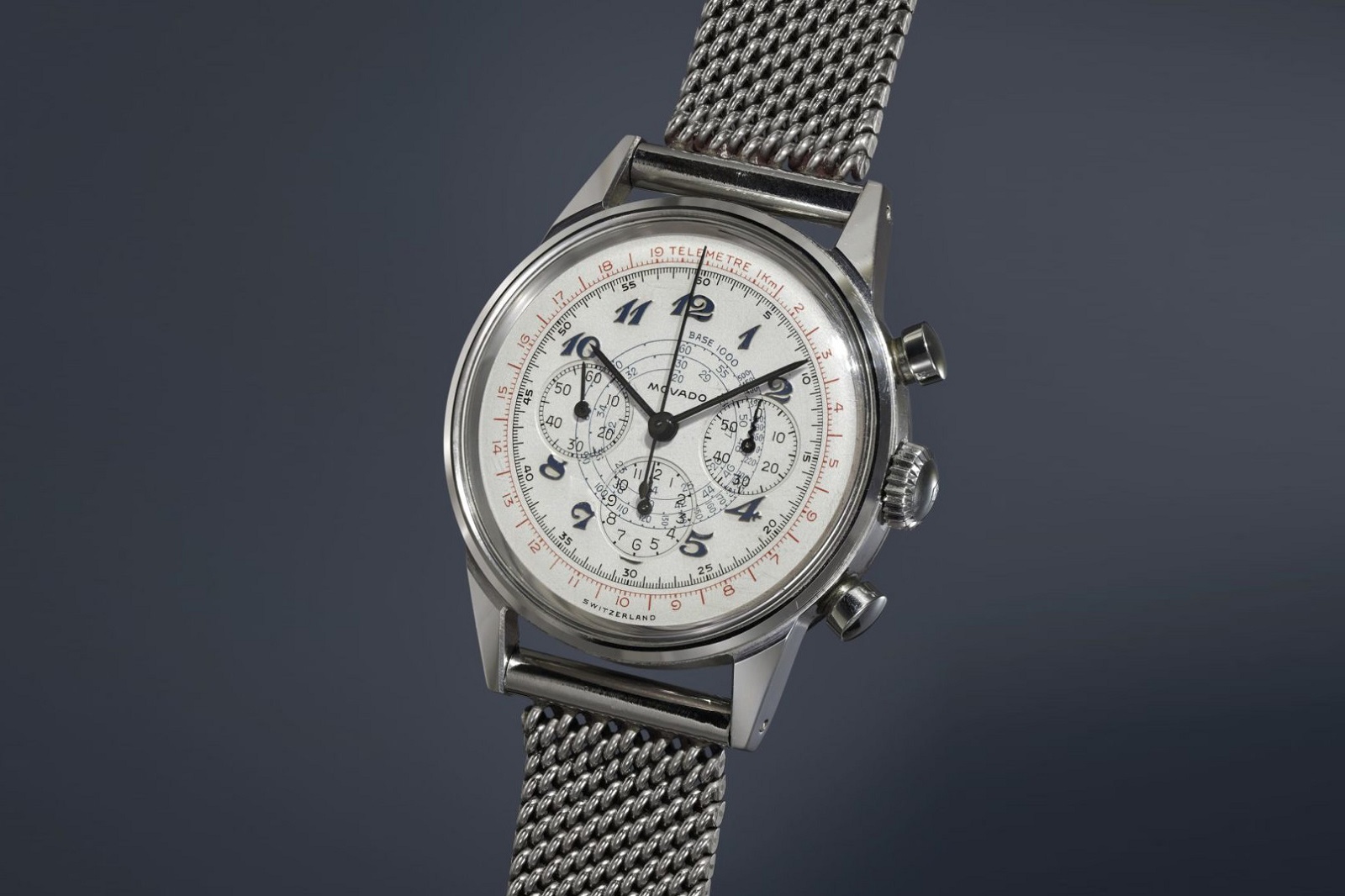
The Type 2 faceted case of a “95 704 568”. Image – Phillips
Non-FB cases
FB was the only case maker that produced sea-worthy Movado chronographs. However, Movado did offer a variety of chronographs with snap-back cases that typically housed the two-register M90. These chronographs featured the same dials, hands, and movements as models with FB cases. Yet, due to their construction and generally older age, many dials in snap-back cases have deteriorated over time, making excellent condition examples difficult to find.
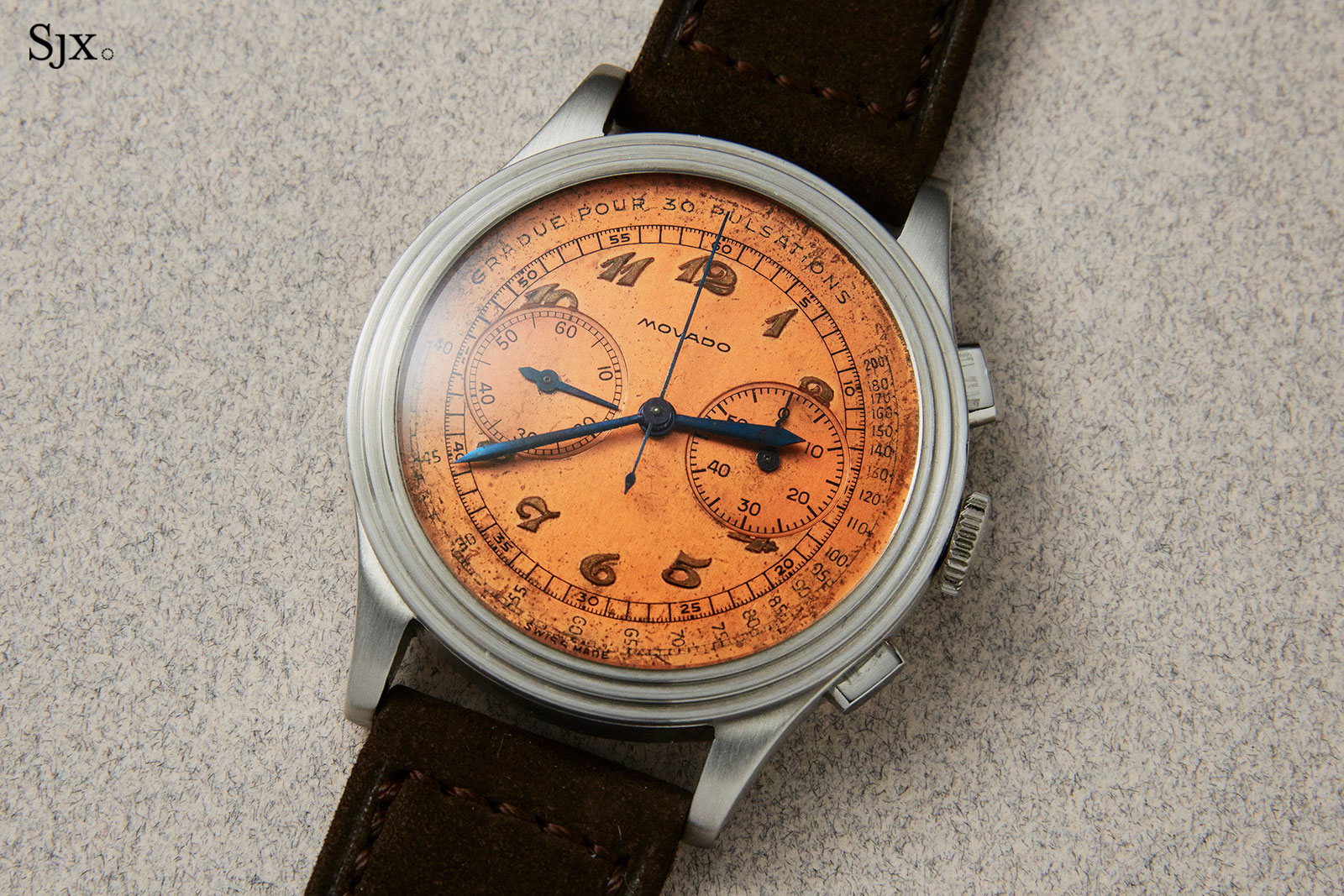
A salmon dial ref. 19005 sold at Phillips in 2018
Among snap-back references, the two most sought after styles are the triple-step bezel and the “disco volante”. The triple-step, or case number “05”, is 34.5 mm and features broad, traditionally sloping lugs with rectangular pushers. It has horizontal brushing on the case sides, opposite of the vertical brushing on FB cases, and a flat, unsigned crown.
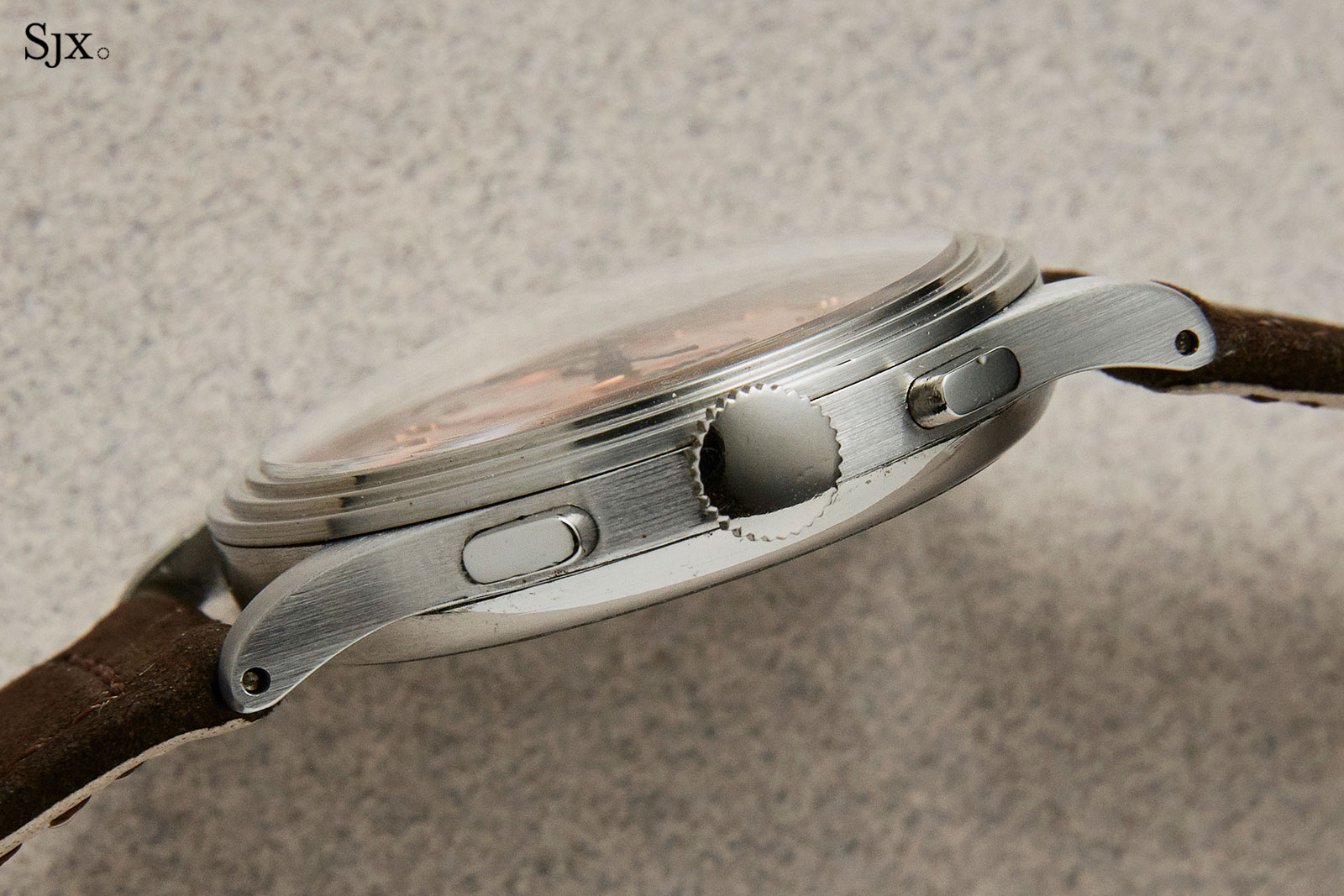
The mid case of the salmon dial 19005
Case number “04” gets its nickname “disco volante”, Italian for “flying saucer”, from its ample, lug-less case. It is similarly sized to the triple-step case and has the same horizontally-brushed case band finish, with rectangular pushers and a flat crown. The slim bezel allows for a wide dial, creating visual balance with the lug-less case and providing a larger-than-measured presence on the wrist. To achieve its shape, it has recesses below the bezel where curved, fixed spring bars are fitted. Of all the case styles, the “disco volante” seems to be the rarest.
Even accounting for specimens with refinished dials, I have documented less than 15. Interestingly, most were delivered to France, with “Fab. Suisse” – a requirement for watches exported for sale in France – stamped on the case back and sometimes printed on the dial. “Disco” dials also tend to be more complex, such as this beautifully proportioned, two-tone example with three-ring tachymeter scale and Arabic numerals.
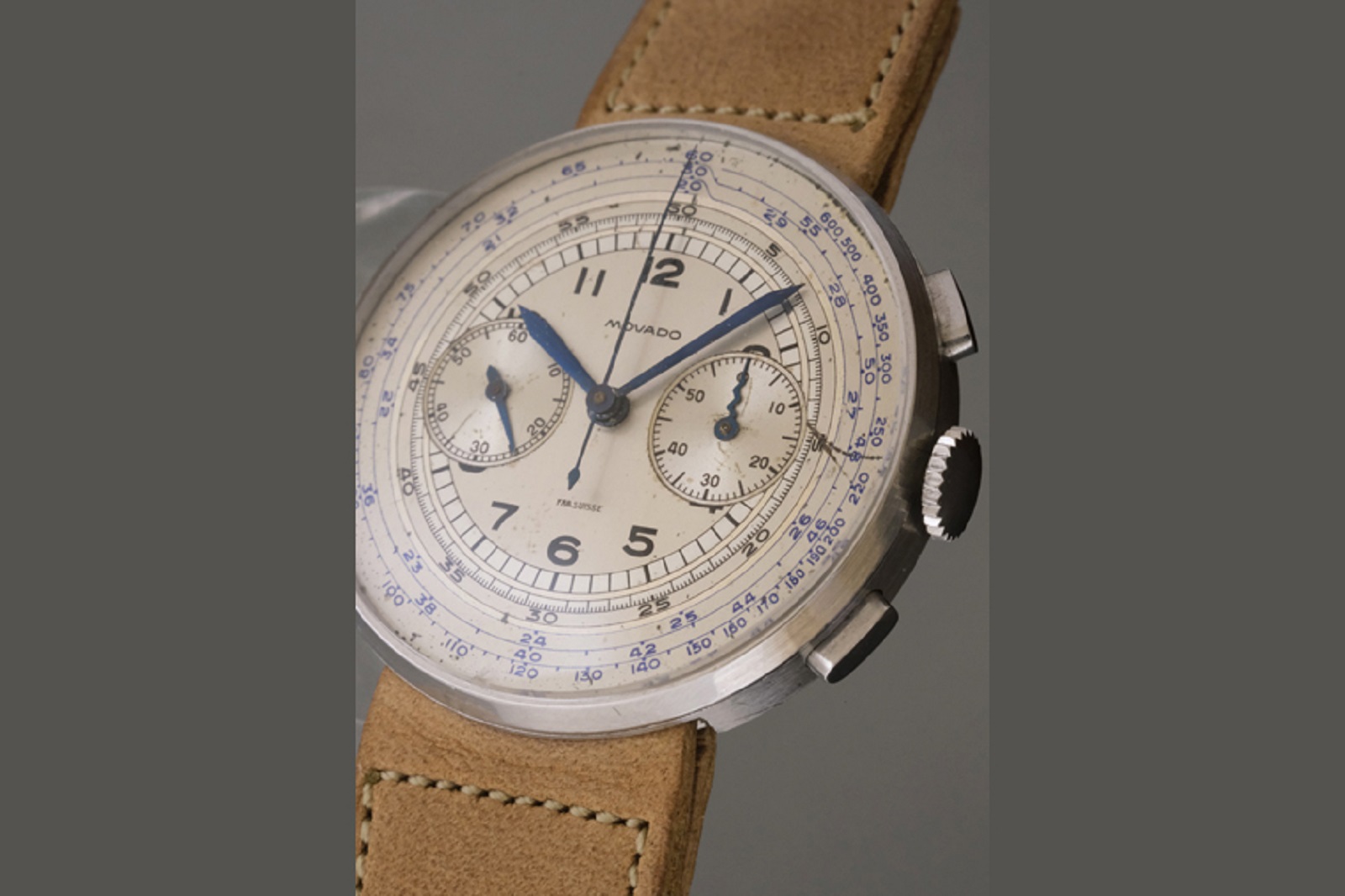
A 19004. Image – Shellman
The two other non-FB cases most frequently seen are those with stepped lugs (“33” and “43”) and faceted lugs (“26” and “36”)
These share the same crown and pusher style as the “disco volante” and triple step but are larger at 38 mm and 36 mm respectively. Despite the large sizes, which normally translates into collectability, examples with these cases tend to be less visually compelling because of the dials.
They are not seen with the broad, sword-shaped blued hands or Breguet numerals found on the triple step and “disco.” They also tend to have less complex dial designs, possibly due to the expansive size. However, if either of the case styles have an interesting dial in good condition, they can still impress and may deserve more attention than they’re given.
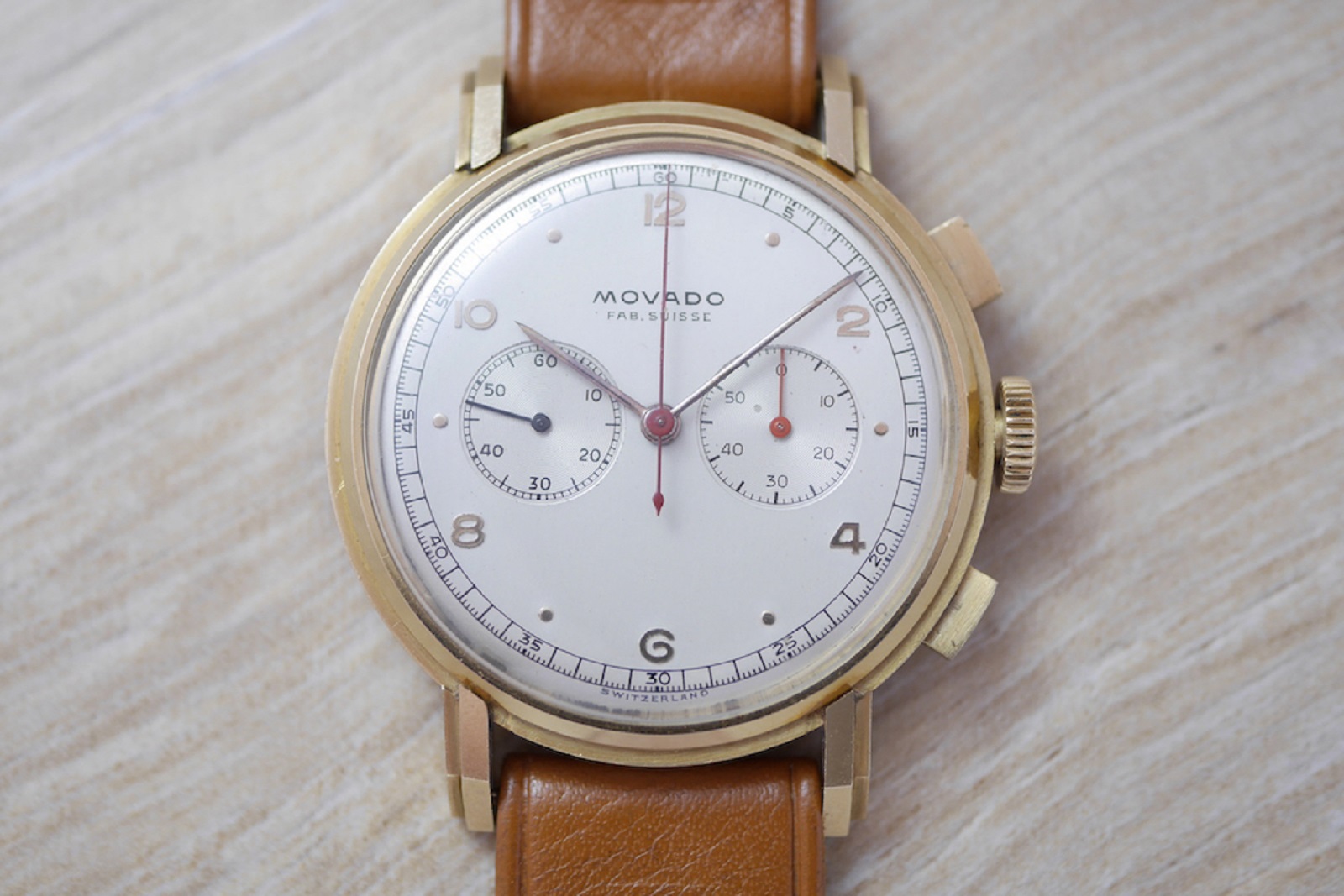
A 9033. Image – Mim & Crocket
And then there are the non-FB cases in small sizes that result in more limited collectability today. The most appealing of these is the cushion cased “13”, which wears slightly larger than its 30.5 mm diameter due to its shape. Other styles, like the “01” or “06”, share the appealing aesthetics of the triple step and “disco” but are too small for most collectors.
Finally, there exists a unique, non-FB case in platinum with hinged lugs known as ref. 9798, which houses an M95 and sold for almost CHF50,000 in 2008. It seems to have been created specifically to upend all the norms of the model taxonomy. Without rules to break, where would the fun be?
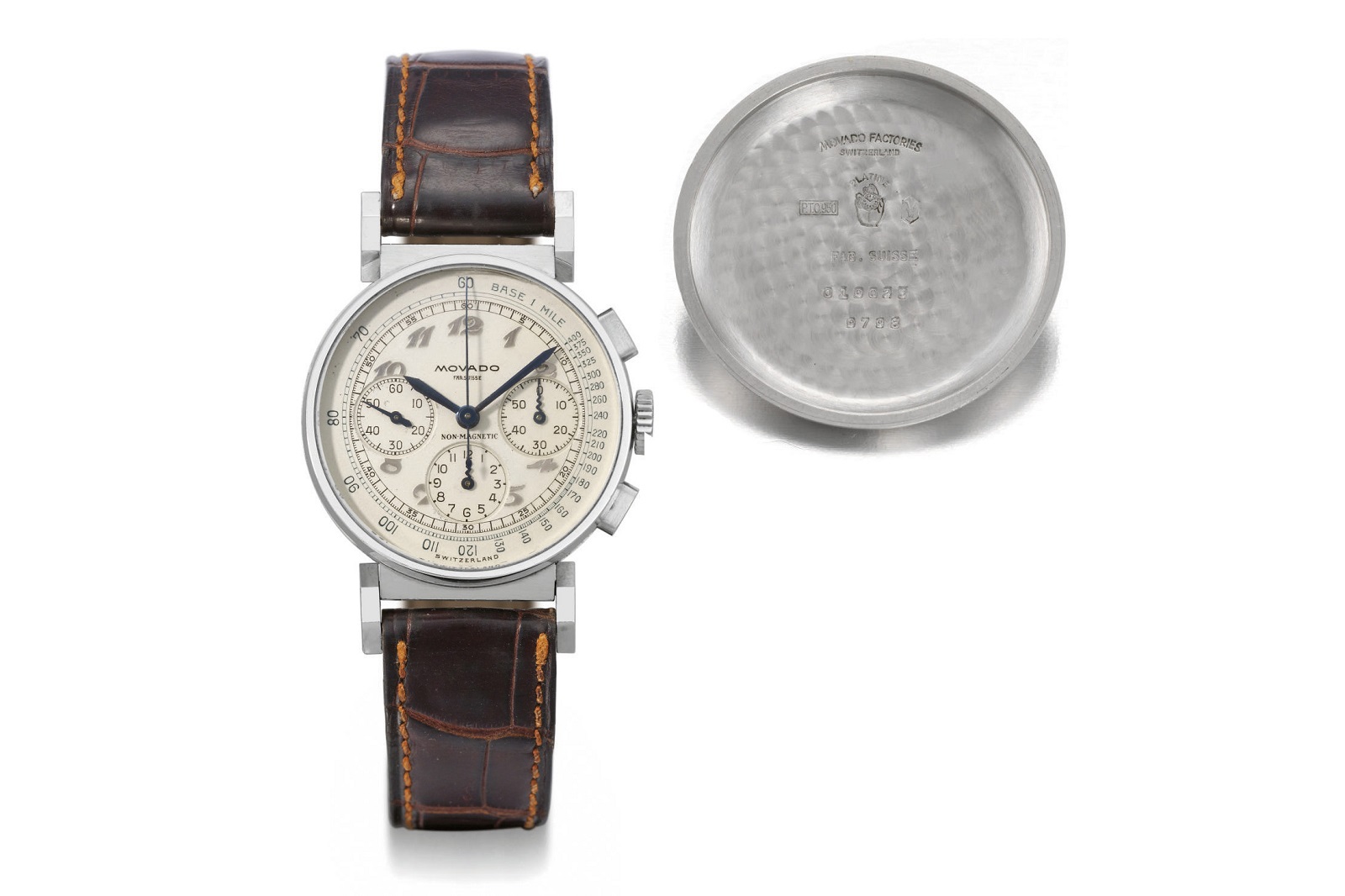
The platinum 9798. Image – Christie’s
The 565 cases
We now come to the white whale of mid-century Movado, the “08”. This FB-cased screwback M90 is often referred to as the “565” for its monocoque construction that mirrors another, more famous FB-cased wristwatch, the Patek Philippe ref. 565.
Simply put, the “08” is the best of all worlds. At 35 mm, the “08” has unusual, broad lugs that extend outwards in an uninterrupted plane from the dial and bezel-less case. It also features the familiar domed crown and sunburst pushers of the cylinder cases and Patek Philippe ref. 1463.
Equally appealing, the dials found on the “08” were frequently executed with interesting colours (including salmon and black “gilt”), sword-shaped hands, and Breguet numerals. There is little to do but repose in awe at what might be the ultimate mid-century chronograph, which I write with little hesitation but plenty of bias. They epitomise “shipshape and Bristol fashion”, and owning one with a pulsations scale and Breguet numerals is a personal goal of mine.
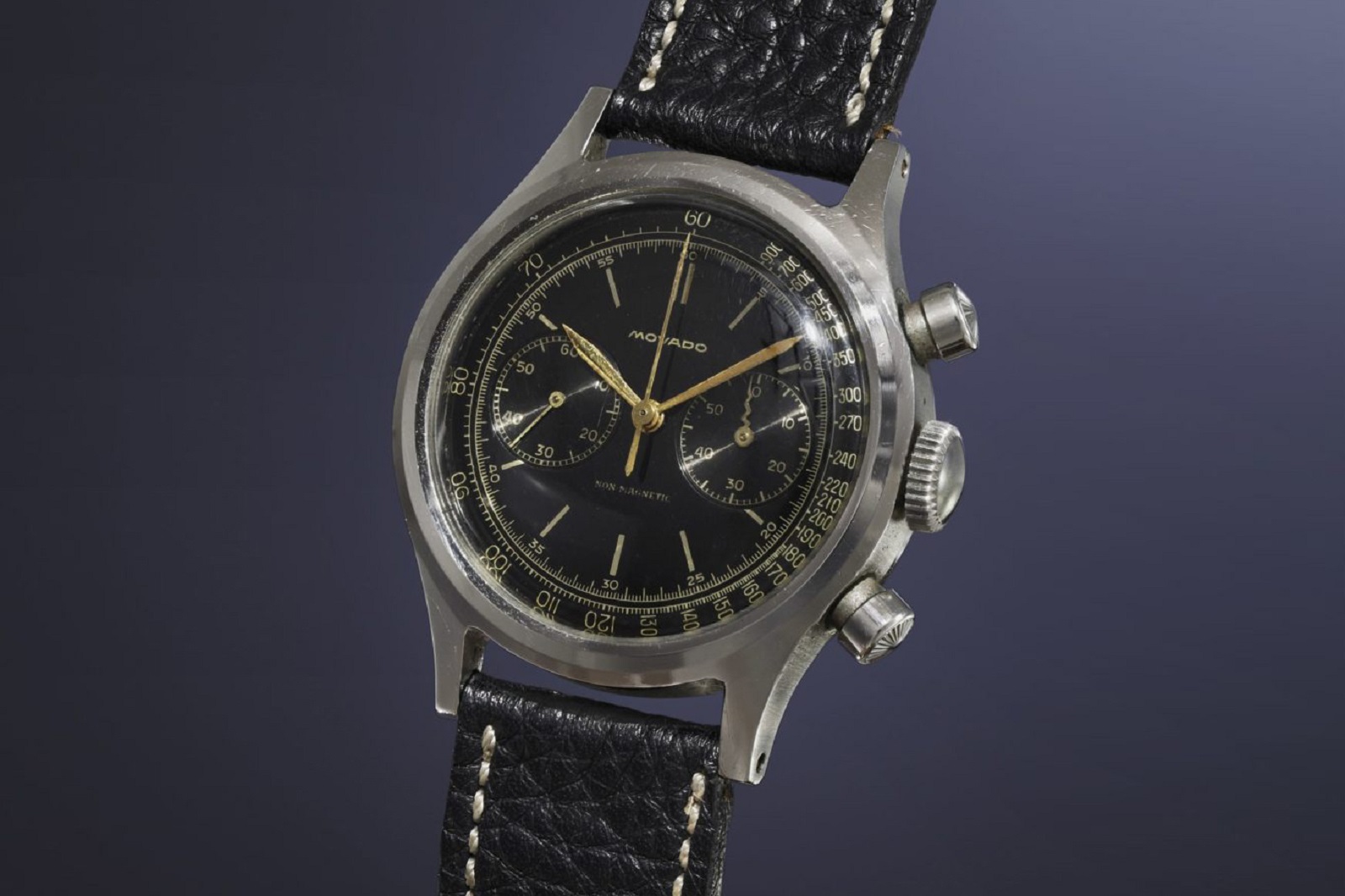
A 19008. Image – Phillips
The Melville amongst these giants is the military-issue version of the “08” on page 118 of The Movado History by van Osterhausen, thought to be a prototype never put into production.
It has a black dial with an Explorer-style dial and single, clearly-graduated and oversized minute totaliser at three o’clock. For the sake of the wider watch community, I hope it comes up for public sale at some point in my life.
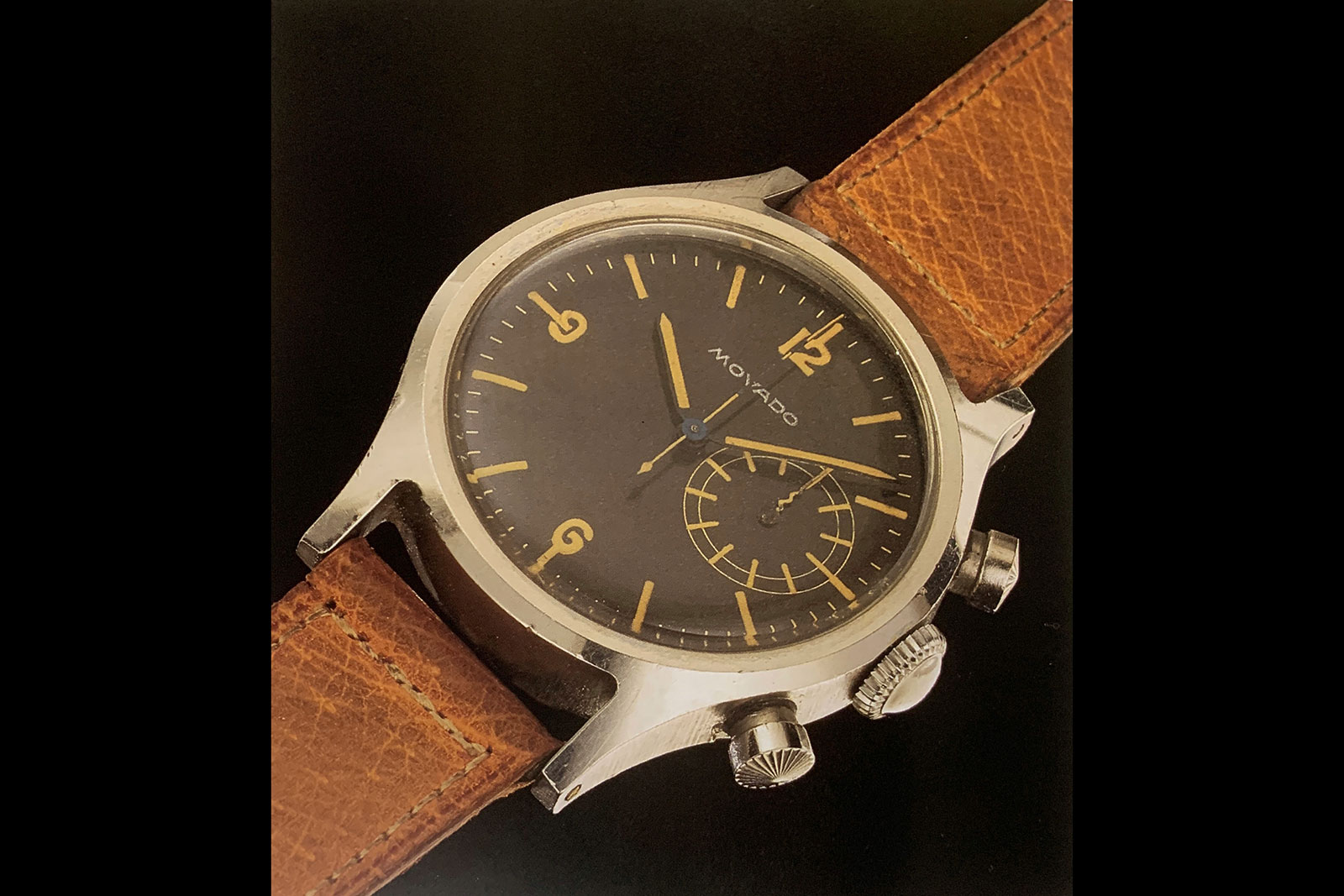
The military prototype 19008. Image – The Movado History
Our dénouement reached, this benthic tale of case lore comes to a close, for now. As much as I’ve espoused on mid-century Movado chronographs, more remains unknown than known. I hope this nascent report on the uncharted depths inspires more scholarship and a reawakening of midcentury Movado for the wider horological community. And as they say in Bristol, I wish you “fair winds and following seas” on your collecting journey.
The author is a medical doctor with a scholarly interest in several genres of vintages watches, including Movado chronographs. He is building a database on vintage Movado chronographs, and can be reached via @t_swiss_t on Instagram.
Back to top.

